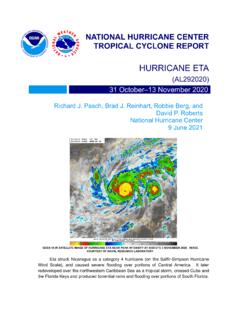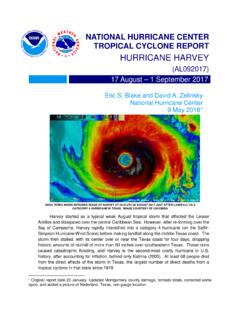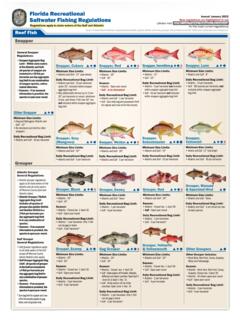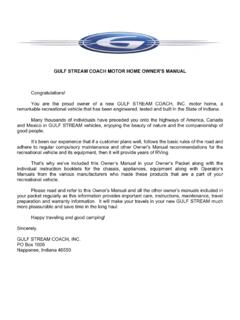Transcription of Cocaine from South America to the United States
1 31limited to refueling. After 2000, and especially after 2006, law enforcement increased the risks of shipping directly to mexico . Consequently, Central America took on new importance as a transit and storage area, and parts of the Caribbean were can be seen in the seizure figures. In the mid-1980s, over 75% of the Cocaine seized between South America and the United States was taken in the Caribbean, and very little was seized in Central America . By 2010, the opposite was true: over 80% was seized in Central America , with less than 10% being taken in the Caribbean. The bulk of the Cocaine seized in recent years in the Caribbean has been taken by the Dominican Republic, which is also a transit country for the European is the trafficking conducted?
2 Despite reductions in production, the latest Cocaine signa-ture data indicates that most of the Cocaine consumed in the United States comes from The Colombian government has been extremely successful in disassembling the larger drug trafficking organizations, and this has changed the nature of the market in the country. While large groups like the Rastrojos and the Urabe os exist, they are not powerful enough to threaten the state or eliminate all interlopers. Rather, a free market exists in which a wide range of players can source Cocaine , and this is manifest in the diversity of trafficking styles and The Dominican Republic is by far the most frequent source of Cocaine courier flights to European destinations, and has recently been the source of some large maritime shipments destined for Valencia, United States Cocaine Signature ProgramWhat is the nature of this market?
3 The history of Cocaine trafficking from South America to the United States has been well documented. The flow peaked in the 1980s. During most of this time, Colombian traffickers dominated the market, and they often preferred to use the Caribbean as a transit area. Due to vigorous law enforcement, the Colombian groups were weakened in the 1990s, and Mexican groups progressively assumed control of most of the trafficking chain. As a product of this shift, an ever-increasing share of the Cocaine entering the United States did so over the South -western land border. Initially, direct shipments to mexico were favoured, with stopovers in Central America largely Cocaine from South America to the United StatesFigure 22: Number of primary Cocaine move-ments destined for, or interdicted in, Central America , the Caribbean, and mexico , 2000-2011 Source.
4 ONDCP01002003004005006007008002000200120 02200320042005200620072008200920102011 Number of movements detectedCentral AmericaMexicoCaribbeanTransnaTional organized Crime in CenTral America and The Caribbean32 Focused law enforcement in Colombia has also reduced the number of shipments departing directly from the country. Shipments by air mostly take off just across the border, in Venezuelan territory. Shipments by sea are increasingly embarking from Ecuador on the Pacific and the Bolivarian Republic of Venezuela on the Atlantic. Until 2009, a large share of the flights were destined for the Dominican Republic, but much of this air traffic appears to have been re-routed to Honduras after 2007, particularly following the Zelaya coup in 2009.
5 Today, in addition to many minor sub-flows, there are three main arteries for northward movement of Cocaine : Pacific fishing boats and other marine craft, including semi-submersibles, particularly destined for Guatemala, supplying Cocaine to the Cartel del Pac fico. Atlantic go-fasts and other marine craft, including some semi-submersibles, particularly destined for Honduras, to supply both the Cartel del Pac fico and the Zetas. Aircraft, departing from the border area of the Boli-varian Republic of Venezuela, particularly destined for Honduras, supplying both the Cartel del Pac fico and the has been made of the use of self-propelled semi-submersibles (SPSS), and there have indeed been some spectacular seizures, including recent ones off the coasts of Honduras and Guatemala.
6 These devices began as submersed trailers off other vessels that could be cut loose in the event of law enforcement contact, but they have evolved considerably since then. True submarines have also been detected, causing considerable alarm. But while the potential for profit is great, so are the losses when an SPSS is detected, and the Colombian government alone has seized at least 50 of them. In addition to the cost of the vessel, an SPSS usually carries multiple tons of Cocaine , costing US$10 million or more in Colombia. And SPSS are generally very slow, so while they are hard to detect, there is more time to detect detected in 1993, seizure of these vessels appears to have peaked between 2007 and 2009, and to have declined since.
7 The United States government notes a reduction of 70% in the estimated use of SPSS between 2009 and It may well be that traffickers are returning to more traditional methods of moving their drugs. Go-fast boats, a perennial favourite, seem to be making a comeback along both use of aircraft, previously largely reserved for short hops to the Caribbean, has also increased. Light aircraft such as the Cessna Conquest and the Beechcraft Duke seem to be preferred, but larger aircraft have been detected. They may make several short hops between remote areas in Panama, Costa Rica, Nicaragua, Honduras, and Guatemala.
8 These areas are often not accessible by road, and so rely on small airstrips or jetties for all contact with the outside world. Using both light aircraft and go-fast boats, Cocaine can be moved northward in an endless series of combinations, touching down in areas the police rarely is very difficult to traffic large volumes of Cocaine by land from Colombia, due to the Darien Strip, a near-impassible stretch of jungle between the country and Panama. To circumvent this barrier, some traffickers make the short sea voyage to Panama from the Golf of Uraba on the Atlantic (about 55% of the detected shipments) or Jurado on the Pacific (45%).
9 Traffickers simply wait for a break in the security patrols before making the trip, using a wide range of sea craft. On the Pacific side, this can involve rather slow artisanal boats. Loads are consolidated in Panama, often in areas inaccessible by road, before being shipped further who ply this leg are mainly Colombians and Pana-manians, transportistas handling the cargo of others. The country serves as both a storage and re-shipment zone. Authorities estimate that perhaps 5% to 10% of the Cocaine entering the country is consumed locally, but although Panama has the highest adult Cocaine use prevalence in Central America (reported to be in 2003), this is dif-ficult to believe given the huge volumes transiting the country.
10 Authorities also say as much as a third may eventu-ally make it to Europe, often flowing via the Dominican Republic, although local police only detected five Europe-bound shipments in 2011. The bulk proceeds shipments from the Bolivarian Republic of Vene-zuela and Ecuador also transit Panamanian waters. Panama routinely makes some of the largest Cocaine seizures in the world. Between 2007 and 2010, around 52 tons were seized 32 Office of National Drug Control Policy, Cocaine Smuggling in 2010. Washington, : Executive Office of the President, 23: Number of primary Cocaine move-ments destined for, or interdicted in, Honduras and the Dominican Republic, 2000-2011 Source: ONDCP05010015020025020002001200220032004 2005200620072008200920102011 Number of movements detectedDominican RepublicHonduras33 Cocaine from South America to the United Statesper year an average of a ton a week.
















